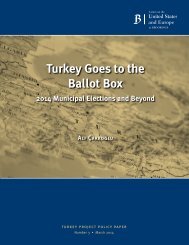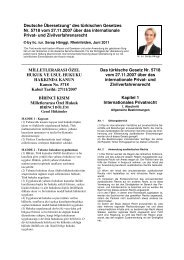WASTEWATER
World%20Water%20Development%20Report%202017
World%20Water%20Development%20Report%202017
You also want an ePaper? Increase the reach of your titles
YUMPU automatically turns print PDFs into web optimized ePapers that Google loves.
Published in 2017 by the United Nations Educational, Scientific and Cultural Organization,<br />
7, place de Fontenoy, 75352 Paris 07 SP, France<br />
© UNESCO 2017<br />
This report is published by UNESCO on behalf of UN-Water. The list of UN-Water Members and Partners<br />
are available on: www.unwater.org<br />
Chapters 2, 4 and 7: The author is a staff member of the World Health Organization. The author alone is<br />
responsible for the views expressed in this publication and they do not necessarily represent the views, decisions or<br />
policies of the World Health Organization. Nothing contained herein shall be construed as a waiver of any of the<br />
privileges and immunities enjoyed by WHO to any national court jurisdiction.<br />
Chapter 7: The views expressed in this publication are those of the author(s) and do not necessarily reflect the views<br />
or policies of the Food and Agriculture Organization of the United Nations.<br />
Chapter 9: by Annukka Lipponen; contributor to Chapter 3: Nataliya Nikiforova © United Nations<br />
Chapters 12, 15, 16, 17: The opinions expressed and arguments employed herein are solely those of the author(s)<br />
and not necessarily reflect the official views of the OECD or of its member countries.<br />
ISBN 978-92-3-100201-4<br />
Suggested citation:<br />
WWAP (United Nations World Water Assessment Programme). 2017. The United Nations World Water Development<br />
Report 2017. Wastewater: The Untapped Resource. Paris, UNESCO.<br />
This publication is available in Open Access under the Attribution-ShareAlike 3.0 IGO (CC-BY-SA 3.0 IGO) license<br />
(creativecommons.org/licenses/by-sa/3.0/igo/). By using the content of this publication, the users accept to be<br />
bound by the terms of use of the UNESCO Open Access Repository (www.unesco.org/open-access/terms-useccbysa-en).<br />
The present license applies exclusively to the text content of the publication. For the use of any material not clearly<br />
identified as belonging to UNESCO, prior permission shall be requested from: publication.copyright@unesco.org or<br />
UNESCO Publishing, 7, place de Fontenoy, 75352 Paris 07 SP France.<br />
The designations employed and the presentation of material throughout this publication do not imply the<br />
expression of any opinion whatsoever on the part of UNESCO concerning the legal status of any country, territory,<br />
city or area or of its authorities, or concerning the delimitation of its frontiers or boundaries.<br />
The ideas and opinions expressed in this publication are those of the authors; they are not necessarily those of<br />
UNESCO and do not commit the Organization. The contents were contributed by the UN-Water Members and<br />
Partners listed on the title pages of the chapters therein. UNESCO and the United Nations World Water Assessment<br />
Programme (WWAP) are not responsible for errors in the content provided or for discrepancies in data and content<br />
between contributed chapters.<br />
WWAP provided the opportunity for individuals to be listed as authors and contributors or to be acknowledged in<br />
this publication. WWAP is not responsible for any omissions in this regard.<br />
Original cover design by Phoenix Design Aid<br />
Printed by UNESCO CLD<br />
This publication is printed in vegetable inks on FSC Mixed Sources paper, supporting responsible use of forest reserves, 100%<br />
recycled, acid-free and chlorine-free.<br />
Printed in France




